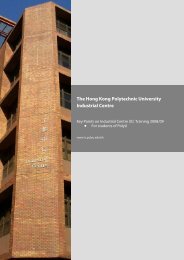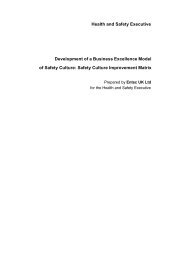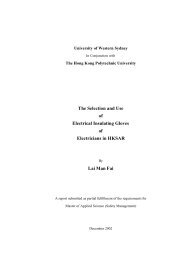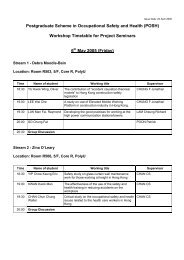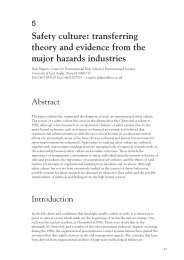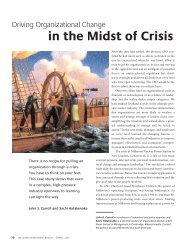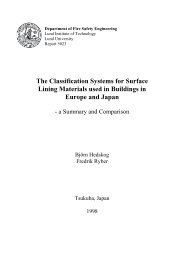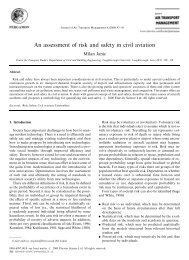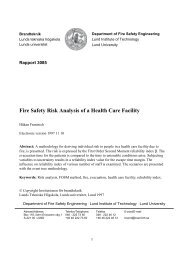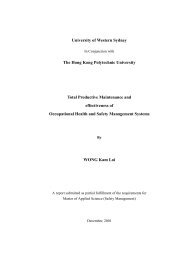Assessing safety culture in offshore environments - Industrial Centre
Assessing safety culture in offshore environments - Industrial Centre
Assessing safety culture in offshore environments - Industrial Centre
You also want an ePaper? Increase the reach of your titles
YUMPU automatically turns print PDFs into web optimized ePapers that Google loves.
126 S.J. Cox, A.J.T. Cheyne / Safety Science 34 (2000) 111±129ences between managers, production teams and drill<strong>in</strong>g teams. A series of one-wayanalyses of variance were performed for each factor <strong>in</strong> the attitude questionnaire.Di€erences <strong>in</strong> mean scores (standardised to a 10-po<strong>in</strong>t scale for each factor) for eachof the three groups are shown <strong>in</strong> Table 6.Di€erences were found <strong>in</strong> six of the questionnaire dimensions with drill<strong>in</strong>g teamsshow<strong>in</strong>g signi®cantly lower evaluations than managers <strong>in</strong> terms of Supportiveenvironment, Involvement, Personal appreciation of risk and Work environmentand lower evaluations of Communication and Personal priorities than both managersand production teams. Production teams, however, only di€ered signi®cantlyfrom managers <strong>in</strong> terms of Involvement, Personal appreciation of risk and workenvironment. These ®nd<strong>in</strong>g are consistent with those of Mearns et al. (1998) suggest<strong>in</strong>gthat drill<strong>in</strong>g teams, who often belong to another `parent organisation' mayhave their own sub-<strong>culture</strong> and may, consequently, ®nd themselves outside variouscommunication channels.4.2. DiscussionUsers found the process straightforward and found little diculty <strong>in</strong> construct<strong>in</strong>gtheir <strong>safety</strong> climate pro®le. Users then exam<strong>in</strong>ed the <strong>in</strong>itial questionnaire items and<strong>in</strong>terview responses <strong>in</strong> order to get some notion of the exact nature of any problemshighlighted by poor scores. This <strong>in</strong>vestigation revealed that a large number ofemployees felt that they were not <strong>in</strong>volved, <strong>in</strong>, or <strong>in</strong>formed of, <strong>safety</strong> <strong>in</strong>itiatives,<strong>in</strong>deed it was perceived that a small group of `select' people were the only <strong>in</strong>dividuals<strong>in</strong>volved <strong>in</strong> any <strong>safety</strong> activities, and these <strong>in</strong>dividuals gave little, or no, support toothers on <strong>safety</strong> issues. These feel<strong>in</strong>gs were also re¯ected with regard to <strong>safety</strong>tra<strong>in</strong><strong>in</strong>g. Once aga<strong>in</strong>, the majority of those questioned felt that they were not<strong>in</strong>formed of relevant tra<strong>in</strong><strong>in</strong>g or encouraged to attend courses, other than thoselegally required.Several <strong>in</strong>itiatives are planned as a result of these ®nd<strong>in</strong>gs. Firstly, the users havedecided to actively promote, with the help of the tra<strong>in</strong><strong>in</strong>g manager, the range of<strong>safety</strong> tra<strong>in</strong><strong>in</strong>g courses on o€er. This <strong>in</strong>volves list<strong>in</strong>gs of appropriate coursesappear<strong>in</strong>g <strong>in</strong> the company newsletter, as well as announcements at all team meet<strong>in</strong>gs<strong>in</strong> an attempt to reach the various `sub-<strong>culture</strong>s'. Team meet<strong>in</strong>gs are also to be used,<strong>in</strong> the ®rst <strong>in</strong>stance, to encourage <strong>in</strong>dividuals to get <strong>in</strong>volved <strong>in</strong>, and <strong>in</strong>deed to propose,new <strong>safety</strong> <strong>in</strong>itiatives. The user will reassess the <strong>safety</strong> climate pro®le whenthese measures have been <strong>in</strong> place for at least 1 year.5. DiscussionThis paper has described the development of an <strong>in</strong>novative approach to assess<strong>in</strong>g<strong>culture</strong>, and speci®cally <strong>safety</strong> <strong>culture</strong> and climate. The development of the ``SafetyClimate Assessment Toolkit'' has exploited the notions of multiple organisationalperspectives and data triangulation (Jick, 1979). It utilises approaches which can becomb<strong>in</strong>ed to provide an <strong>in</strong>-depth picture of an organisation's current <strong>safety</strong> climate.



